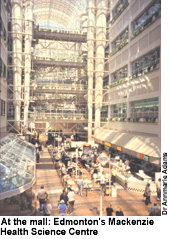
 Ever
felt like blowing up a hospital? You're not alone. When
Calgary General Hospital, built in 1953, was demolished
in 1998, the gathered crowd exploded with applause. Today's
hospital designers insist they're taking a more humanist
approach, but are the US-inspired mega-hospitals cropping
up across Canada really such a great idea for us? Ever
felt like blowing up a hospital? You're not alone. When
Calgary General Hospital, built in 1953, was demolished
in 1998, the gathered crowd exploded with applause. Today's
hospital designers insist they're taking a more humanist
approach, but are the US-inspired mega-hospitals cropping
up across Canada really such a great idea for us?
NOURISHING
BUILDINGS
McGill University Health Centre (MUHC) is about to test
those waters with its gargantuan mega-hospital in construction
west of downtown Montreal (another mega-hospital is
being planned northeast of downtown). "We're shifting
from an old paradigm where we fix the patients, to a
new paradigm where we nourish the patient and help them
heal themselves," enthuses Chief Planning Officer Mr
Jean Dufresne. "If you look at a brick wall all day,
patients don't heal as fast as when they look at a tree.
If you can reduce stress, the patients will heal faster
and their stay at the hospital will be shorter."
Not everyone's quite as sold on
the idea, though. "We don't know how patients or providers
are affected by these spaces," cautions Dr Patricia
McKeever, co-director of the Canadian Institutes of
Health Research Strategic Training Program in Health
Care, Technology and Place at the University of Toronto.
"No one has done evidence-based research to show that
new buildings are better than the old."
HEALING
ENVIRONMENT
Most early hospitals were utilitarian buildings stripped
bare with everything painted a sterile white. More recent
hospital designs have striven to create a "healing environment,
with a return to colour, human affect and a more intimate
scale," according to Dr Annmarie Adams, an associate
professor at the McGill School of Architecture. As director
of Medicine by Design, a project funded by the CIHR,
Dr Adams' top focus is the history of hospital architecture
in Canada.
The shift toward patient-centred
hospitals goes back to the late 70s when Canadian designers
rebelled against the boxy hospitals of the 50s. Then
came the financial squeeze of the 80s. "In the 80s there
were incredible changes in the way healthcare was delivered,"
says Dr McKeever. "IVs and ventilators went into patients'
homes — under fiscal pressure." The result was
that homes became more like hospitals, and hospitals
became more like homes.
CONTROL
FREAKS...
'Patients' rights' are the bywords of the 21st-century
planning movement. Ward-based hospitals were great for
nurses and doctors, but patients were left with nowhere
to hide from prying eyes during their hospital stay.
In Mr Dufresne's view, giving patients control over
their environment is key. "So we have a high ratio of
private rooms, which allow the patient to close their
door," he says. "There are places in the States where
children get to choose their own wall hangings. So we'll
offer kids a choice of posters, because some like Britney
Spears, some like Metallica."
Britney aside, Dr Adams isn't so
sure this is the way to go. "I'm worried about the trend
toward exclusively private rooms," says Dr Adams. "We're
blindly following US models, but we have very different
healthcare systems." It's still unclear if patients
will be charged for the privilege of their newfound
privacy.
...
AND MALL RATS
And the trend in the ultra-capitalist USA is to model
hospitals on Americans' favourite hangout: the mall.
Canada's hit the shops with gusto; Toronto and Edmonton
both already have successful mall-style hospitals. Toronto's
Hospital for Sick Children Atrium Patient Tower, built
in 1993, drew on the innovative design of the Walter
Mackenzie Health Sciences Centre in Edmonton, 1986 (pictured).
"Rather than looking like an office building, it looks
more like a mall," says Dr Adams. "It has a grand atrium
with a glass roof and many levels. Each area looks out
onto the others, so everyone can see everyone else:
you can see patients in wheelchairs and stretchers going
down to the food fair, sitting in lounges, watching
TV."
The mall look is no coincidence:
both hospitals were designed by Zeidler Roberts Partnership
Architects, the firm that gave us Toronto's Eaton Centre.
They're similar in more ways than one — the mall
hospitals literally have shops and a food fair. "We're
seeing the invasion of fast-food and retail outlets,"
observed Dr Adams. "You can get out of your room and
have a cheeseburger, buy a Roots t-shirt."
So will the MUHC look like a medical
mall? "Yes, absolutely!" says Mr Dufresne. "You want
to reproduce the environment people are comfortable
with."
The mall model may get people spending,
but there's no proof that it speeds up healing. The
new hospitals may be more comfortable, but Dr Adams
can't help noting the irony of the situation. "We spend
less time in them — patients are in and out in
a day."
|